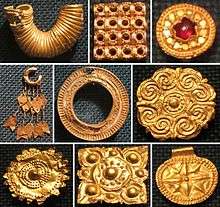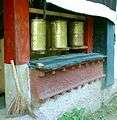Toreutics
The term toreutics, relatively rare in English, refers to artistic metalworking[1][2] - hammering gold or silver (or other materials), engraving, or using repoussé and chasing to form minute detailed reliefs or small engraved patterns.[3] Toreutics can include metal-engraving – forward-pressure linear metal removal with a burin.[4]
| Look up toreutics in Wiktionary, the free dictionary. |
Archeological background
_(9428277598).jpg)
Toreutics claims great antiquity.[5] It was practised in the Bronze Age and was well established centuries before the shaft graves.[6] Toureutic items of special quality from the Iron Age are the Certosa situla from Italy and from Slovenia the Vače situla and the Vače belt-plate. Toreutics flourished to an unusual degree among the peoples of Asia Minor, Assyria, Babylon, and passed from thence to ancient Persia.[7] One spectacular example of the direct influence of Persia in toreutics is believed to be the Treasure of Nagyszentmiklós found in Transylvania in 1799, and considered to be work of Old Bulgarian[8] gold smiths. It consists of 23 vessels and has been attributed to Attila's Huns,[9] the Avars[10] and Pechenegs. The majority of scholars however, consider it Bulgarian (Proto-Bulgarians,[11] Bulgars), because of its runic inscriptions.[12]
Etymology
Toreutics comes from Greek toreutikos:[13] of metal work; from toreutos: worked in relief; from toreuein;[14] to work in relief; from toreus: a boring tool, Proto-Indo-European *terə-. The art of working metal or other materials by the use of embossing and chasing to form minute detailed reliefs. The origin of 'toreutics' goes back to 1830–40; < Gk toreutikós, equiv. to toreú(ein) to bore, chase, emboss (v. deriv. of toreús graving tool) -tikos.
Applications
- Greek style,[15] Inscriptions on toreutics[16]
- Achaemenid–Persian–Sassanid[17] style, Christian toreutics,[18] Folk craftsmanship, Bulgaria
- Beaten copper[19] (Tibet)
- Tsuba gold toreutics (1860) Mito school.
 Toreutics on the roof of Potala Palace (dragon head corner).
Toreutics on the roof of Potala Palace (dragon head corner). Dhvaja on the roof of Sanga Monastery.
Dhvaja on the roof of Sanga Monastery. Gold crafts from the Philippines prior to Western contact.
Gold crafts from the Philippines prior to Western contact. Praying weels in Tsozong Gongba Monastery.
Praying weels in Tsozong Gongba Monastery.
See also
- Aesthetics
- Dhvaja
- European art
- Goldsmith
- History of decorative arts
- Persian-Sassanide art patterns
- Preslav treasure
- Shoami
- Treasure of Nagyszentmiklós
- Umetada
References
- Aesthetics: Lectures on Fine Art Volume II (Aesthetics) by G. W. F. Hegel and T. M. Knox (1998) p.161
- How to Understand Sculpture by Margaret Thomas, Kessinger Publishing, 2005, p.25
- Hutchinson Encyclopaedia. Helicon Publishing LTD 2007
- Jewelry Concepts & Technology by Oppi Untracht (1982) p. 283
- How to Understand Sculpture by Margaret Thomas, Kessinger Publishing, 2005, pp. 25–6
- Social Transformations in Archaeology: Global and Local Perspectives (Material Cultures) by Kri Kristiansen (1998) p.135
- The Cambridge History of Iran by I. Gershevitch (1985) p.154
- A Short History of Modern Bulgaria by R.J. Crampton, Cambridge University Press, 1987
- The Empire of the Steppes, a History of Central Asia by Rene Grousset (transl. by Naomi Walford), Rutgers University Press, 2005, p.25
- Warriors of the Steppe by Erik Hildinger, De Capo Press, 1997, pp. 57–92
- Bulgaria – Land of Ancient Civilizations by Dimiter Dimitrov, Foreign Language Press, Sofia 1961, p.33
- Bulgarian's Treasures from the Past by Ivan Venedikov, Sava Boyadjiev and Dimiter Kartalev, Foreign Languages Press, Sofia 1965, pp. 345–55.
- Sculpture: Some Observations on Shape and Form from Pygmalion's Creative Dream by Johann Gottfried Herder and Jason Gaiger (2002)
- Conspiracy of Catiline and the Jurgurthine War by Sallust (2004/6) p.62/72
- Sideris, A., "Les tombes de Derveni. Quelques remarques sur la toreutique", Revue Archéologique 2000, pp. 3-36.
- Sideris, A., "Bronze Drinking Vases Bearing Dedicatory Inscriptions", Eirene 38, 2002, pp. 167-201.
- Athens and Persia in the Fifth Century BC: A Study in Cultural Receptivity by Margaret C. Miller (2004) p.59. Sideris, A. "Achaemenid Toreutics in the Greek Periphery", in Darabandi S. M. R. and A. Zournantzi (eds.), Ancient Greece and Ancient Iran. Cross-Cultural Encounters, Athens 2008, pp. 339-353.
- The history of the origins of Christianity: Volume 3 by Ernest Renan (2007) p.95
- Antique Brass & Copper Identification & Value Guide by Mary Frank Gaston (1991) p.19